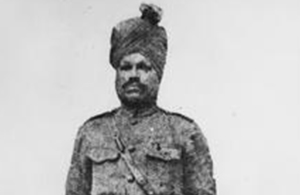WW1 Indian VC recipient Badlu Singh
The story of Indian First World War Victoria Cross recipient Badlu Singh.

Badlu Singh [Credit: © IWM (detail of VC 46)]
6 men from India received the Victoria Cross, Britain’s highest award for gallantry, during the First World War. As part of the Centenary Commemorations the people of the United Kingdom marked their gratitude to those courageous men by presenting a bronze memorial plaque to their home country engraved with their names. This archive tells their stories.
Name: Badlu Singh
DOB: 13 January 1876
Place of Birth: Dhakla, Punjab, India
Date of Action: 23 September 1918
Place of Action: Kh. Es Samariyeh, Palestine
Rank: Risaldar
Regiment: 14th Murray’s Jat Lancers
Badlu Singh was a Hindu Jat, born on 13 January 1876 in Dhakla, in the Punjab, India. He was a Risaldar in the 14th Murray’s Jat Lancers, attached to the 29th Lancers of the Indian Army, who were sent first to France before being withdrawn to fight in Palestine.
Risaldar Badlu Singh was awarded his Victoria Cross posthumously for most conspicuous bravery and self-sacrifice on the banks of the River Jordan in Palestine on 23 September 1918. His citation in the London Gazette describes his actions:
On the morning of the 23rd September 1918, his squadron charged a strong enemy position on the west bank of the river Jordan, between the river and Kh. es Samariyeh village. On nearing the position, Risaldar Badlu Singh realised that the squadron was suffering casualties from a small hill on the left front occupied by machine guns and 200 infantry. Without the slightest hesitation he collected six other ranks and with the greatest dash and total disregard for danger, charged and captured the position, thereby saving very heavy casualties to the squadron. He was mortally wounded on the very top of the hill when capturing one of the machine guns single handed, but all the machine guns and infantry had surrendered to him before he died. His valour and initiative were of the highest order.
Badlu Singh was cremated where he fell, but his name is inscribed on the Heliopolis Memorial at Heliopolis War Cemetery in Cairo. His Victoria Cross is part of the Lord Ashcroft collection at the Imperial War Museum.